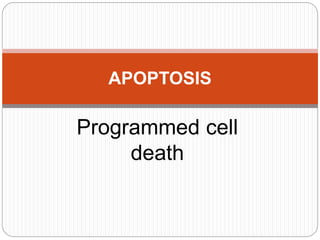
Apoptosis
- 2. Apoptosis helps regulate animal cell numbers If cells are no longer needed, they can commit suicide by activating an intracellular death program—a process called programmed cell death. In animals, by far the most common form of programmed cell death is called apoptosis (Greek word meaning ‘falling off,’) A form of cell death in which a programmed sequence of events leads to the elimination of cells without releasing harmful substances into the surrounding area.
- 4. What purposes does this massive cell suicide serve? Mouse paws—and our own hand and feet—are sculpted by apoptosis during embryonic development: they start out as spade like structures, and the individual fingers and toes separate because the cells between them die When a tadpole changes into a frog at metamorphosis, the cells in the tail die, and the tail, which is not needed in the frog, disappears
- 5. Cell death usually exactly balances cell division, unless the tissue is growing or shrinking Eg. If part of the liver is removed in an adult rat, for example, liver cells proliferate to make up the loss. Conversely, if a rat is treated with the drug phenobarbital, which stimulates liver cell division, the liver enlarges. However, when the phenobarbital treatment is stopped, apoptosis in the liver greatly increases until the organ has returned to its original size, usually within a week or so. Thus, the liver is kept at a constant size through regulation of both the cell death rate and the cell birth rate.
- 6. Cell that undergoes apoptosis dies neatly, without damaging its neighbours. cytoskeleton collapses, the nuclear envelope disassembles, and the nuclear DNA breaks up into fragments. macrophages – cells engulf the apoptotic cell before it spills its contents destructive and self-amplifying but also irreversible
- 7. Machinery that is responsible for apoptosis involves the caspase family of proteases - made as inactive precursors called procaspases. apoptosis is mediated by an intracellular proteolytic cascade.
- 9. Death program is regulated by the bcl2 family of intracellular proteins All nucleated animal cells - inactive procaspases lie waiting for a signal to destroy the cell. main proteins that regulate the activation of procaspases are members of the Bcl2 family Some members of this protein family promote procaspase activation and cell death, whereas others inhibit these processes. most important death-promoting family members are proteins called Bax and Bak.
- 10. Bax and Bak. These proteins activate procaspases indirectly, by inducing the release of cytochrome c from mitochondria into the cytosol. Cytochrome c promotes the assembly of a large, seven-armed pinwheel-like structure that recruits specific procaspase molecules, forming a protein complex called an apoptosome. The procaspase molecules become activated within the apoptosome, triggering a caspase cascade that leads to apoptosis Bax and Bak proteins are themselves activated by other death-promoting members of the Bcl2 family,
- 12. Extracellular signals to survive, Grow, and divide Most of the extracellular signal molecules that influence cell survival, cell growth, and cell division are either soluble proteins secreted by other cells or proteins bound to the surface of other cells or the extracellular matrix. Three major categories: 1. Survival factors promote cell survival, largely by suppressing apoptosis. 2. Mitogens stimulate cell division, primarily by overcoming the intracellular braking mechanisms that tend to block progression through the cell cycle. 3. Growth factors stimulate cell growth (an increase in cell size and mass) by promoting the synthesis and inhibiting the degradation of proteins and other macromolecules.
- 13. Survival factors to avoid apoptosis signals from other cells helps to ensure that cells survive only when and where they are needed Survival factors usually act by binding to cell-surface receptors. These activated receptors then turn on intracellular signaling pathways that keep the death program suppressed, usually by regulating members of the Bcl2 family of proteins. Some survival factors, for example, increase the production of Bcl2, a protein that suppresses apoptosis
- 15. Pathways The Extrinsic Pathway: In the extrinsic pathway, signal molecules known as ligands, which are released by other cells, bind to transmembrane death receptors on the target cell to induce apoptosis. For example, the immune system’s natural killer cells possess the Fas ligand (FasL) on their surface . The binding of the FasL to Fas receptors (a death receptor) on the target cell will trigger multiple receptors to aggregate together on the surface of the target cell. The aggregation of these receptors recruits an adaptor protein known as Fas-associated death domain protein (FADD) on the cytoplasmic side of the receptors. FADD, in turn, recruits caspase-8, an initiator protein, to form the death-inducing signal complex (DISC). Through the recruitment of caspase-8 to DISC, caspase-8 will be activated and it is now able to directly activate caspase-3, an effector protein, to initiate degradation of the cell. Active caspase-8 can also cleave BID protein to tBID, which acts as a signal on the membrane of mitochondria to facilitate the release of cytochrome c in the intrinsic pathway.
- 16. The Intrinsic Pathway: The intrinsic pathway is triggered by cellular stress, specifically mitochondrial stress caused by factors such as DNA damage and heat shock. Upon receiving the stress signal, the proapoptotic proteins in the cytoplasm, BAX and BID, bind to the outer membrane of the mitochondria to signal the release of the internal content. However, the signal of BAX and BID is not enough to trigger a full release. BAK, another proapoptotic protein that resides within the mitochondria, is also needed to fully promote the release of cytochrome c and the intramembrane content from the mitochondria. Following the release, cytochrome c forms a complex in the cytoplasm with adenosine triphosphate (ATP), an energy molecule, and Apaf-1, an enzyme. Following its formation, the complex will activate caspase-9, an initiator protein. In return, the activated caspase-9 works together with the complex of cytochrome c, ATP and Apaf-1 to form an apoptosome, which in turn activates caspase-3, the effector protein that initiates degradation. Besides the release of cytochrome c from the intramembrane
